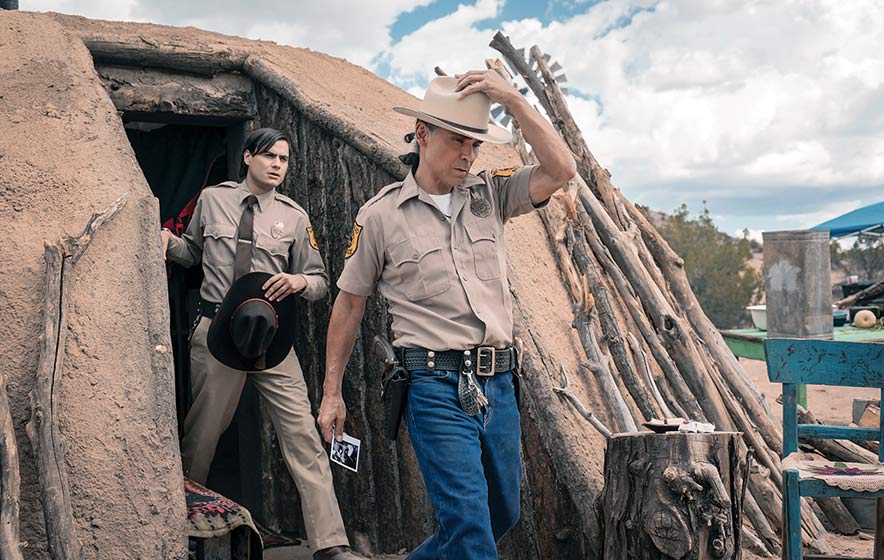
- Details
- By Kaili Berg
AMC’s Dark Winds, the critically acclaimed TV series based on Tony Hillerman's Leaphorn & Chee novels, has recently risen to the top 10 charts on Netflix.
This achievement marks a significant milestone for Native American representation in mainstream media, highlighting the importance of diverse storytelling and the power of Indigenous voices in the entertainment industry.
Set in the 1970s, Dark Winds follows Navajo Tribal Police officers Joe Leaphorn and Jim Chee as they navigate the complexities of crime, culture, and community on the Navajo Nation.
The series, praised for its authentic portrayal of Navajo life and culture, has resonated with viewers for its nuanced storytelling and richly developed characters.
At the heart of Dark Winds are the Native American actors and creators who bring the story to life. Zahn McClarnon, a Lakota actor known for his roles in Westworld and Fargo, stars as Joe Leaphorn. McClarnon’s portrayal of the stoic and determined tribal officer has been lauded for its depth and authenticity.
Alongside him is Kiowa Gordon, a Hualapai actor, who plays Jim Chee, a young and idealistic FBI agent with deep ties to his Navajo roots. Gordon's performance balances the complexities of a character torn between two worlds, adding layers to the show's narrative.
The success of Dark Winds is not just in front of the camera but also behind it. The series is executive produced by Chris Eyre, a Cheyenne and Arapaho filmmaker renowned for his work on Smoke Signals, a groundbreaking film in Native American cinema.
Additionally, Dark Winds benefits from the contributions of a predominantly Native American writers’ room, led by creator and showrunner Graham Roland, a member of the Chickasaw Nation.
This behind-the-scenes representation is crucial in maintaining the series' cultural integrity and delivering a narrative that resonates with both Native and non-Native audiences alike.
Dark Winds has achieved significant success on Netflix, with millions of households streaming the series. For the week of August 19-25, 2024, Dark Winds Season 1 ranked sixth on Netflix's Global Top 10 chart, boasting 2.3 million views and 10 million hours viewed.
Fans of the series have taken to social media to express their admiration, with hashtags like #DarkWinds and #NavajoNation trending on platforms like Twitter. The series has received high ratings from viewers, with many praising its attention to detail and cultural accuracy.
“Who else is watching #DarkWinds on Netflix? It’s a masterpiece. Stunning scenery, brilliant cinematography, riveting storylines, gorgeous cast, fascinating cultural insight. I’m halfway done with the first season and already I don’t want it to end,” tweeted one fan.
As Dark Winds continues to charm audiences on Netflix, its success is likely to inspire more projects that center Indigenous stories and voices.
Viewers are encouraged to watch the series and support other Native-led productions, helping to ensure that diverse voices continue to have a platform in the entertainment industry.
More Stories Like This
Zuni Youth Enrichment Project Takes Top Emerging Artist Apprentices to Phoenix for Artistic Exploration and Cultural ImmersionFrom Dishwasher to Award-Winning Chef: Laguna Pueblo's Josh Aragon Serves Up Albuquerque's Best Green Chile Stew
Rob Reiner's Final Work as Producer Appears to Address MMIP Crisis
Vision Maker Media Honors MacDonald Siblings With 2025 Frank Blythe Award
First Tribally Owned Gallery in Tulsa Debuts ‘Mvskokvlke: Road of Strength’
Help us defend tribal sovereignty.
At Native News Online, our mission is rooted in telling the stories that strengthen sovereignty and uplift Indigenous voices — not just at year’s end, but every single day.
Because of your generosity last year, we were able to keep our reporters on the ground in tribal communities, at national gatherings and in the halls of Congress — covering the issues that matter most to Indian Country: sovereignty, culture, education, health and economic opportunity.
That support sustained us through a tough year in 2025. Now, as we look to the year ahead, we need your help right now to ensure warrior journalism remains strong — reporting that defends tribal sovereignty, amplifies Native truth, and holds power accountable.
 The stakes couldn't be higher. Your support keeps Native voices heard, Native stories told and Native sovereignty defended.
The stakes couldn't be higher. Your support keeps Native voices heard, Native stories told and Native sovereignty defended.
Stand with Warrior Journalism today.
Levi Rickert (Potawatomi), Editor & Publisher


